cooling CHEVROLET CITY EXPRESS 2018 Owner's Manual
[x] Cancel search | Manufacturer: CHEVROLET, Model Year: 2018, Model line: CITY EXPRESS, Model: CHEVROLET CITY EXPRESS 2018Pages: 287, PDF Size: 4.19 MB
Page 15 of 287
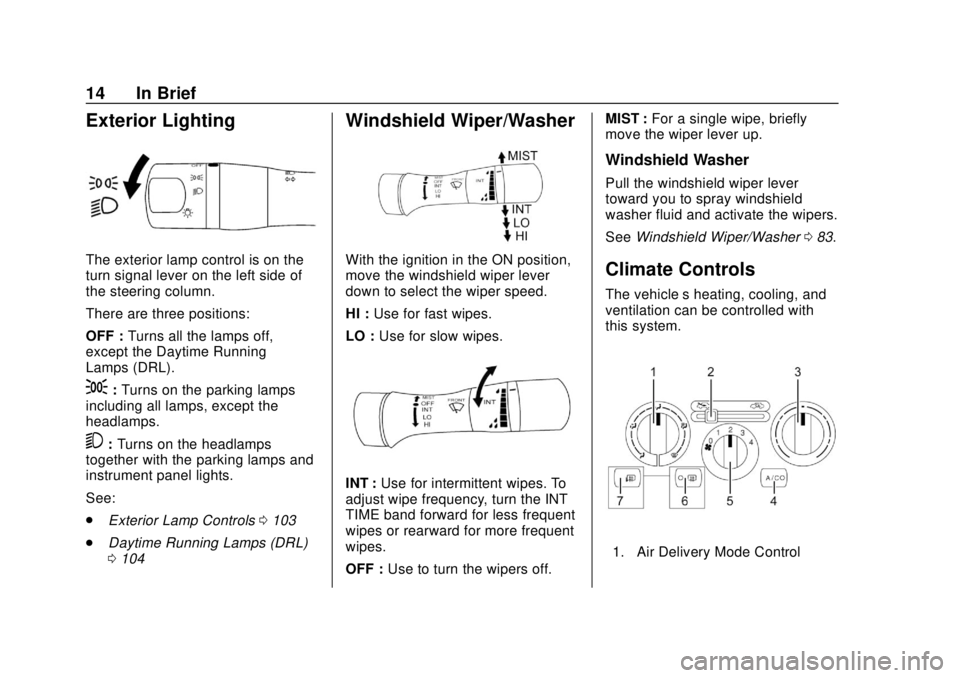
Chevrolet City Express Owner Manual (GMNA-Localizing-U.S./Canada-
11683523) - 2018 - CRC - 7/10/17
14 In Brief
Exterior Lighting
The exterior lamp control is on the
turn signal lever on the left side of
the steering column.
There are three positions:
OFF :Turns all the lamps off,
except the Daytime Running
Lamps (DRL).
;: Turns on the parking lamps
including all lamps, except the
headlamps.
5: Turns on the headlamps
together with the parking lamps and
instrument panel lights.
See:
. Exterior Lamp Controls 0103
. Daytime Running Lamps (DRL)
0104
Windshield Wiper/Washer
With the ignition in the ON position,
move the windshield wiper lever
down to select the wiper speed.
HI : Use for fast wipes.
LO : Use for slow wipes.
INT : Use for intermittent wipes. To
adjust wipe frequency, turn the INT
TIME band forward for less frequent
wipes or rearward for more frequent
wipes.
OFF : Use to turn the wipers off. MIST :
For a single wipe, briefly
move the wiper lever up.
Windshield Washer
Pull the windshield wiper lever
toward you to spray windshield
washer fluid and activate the wipers.
See Windshield Wiper/Washer 083.
Climate Controls
The vehicle’s heating, cooling, and
ventilation can be controlled with
this system.
1. Air Delivery Mode Control
Page 130 of 287
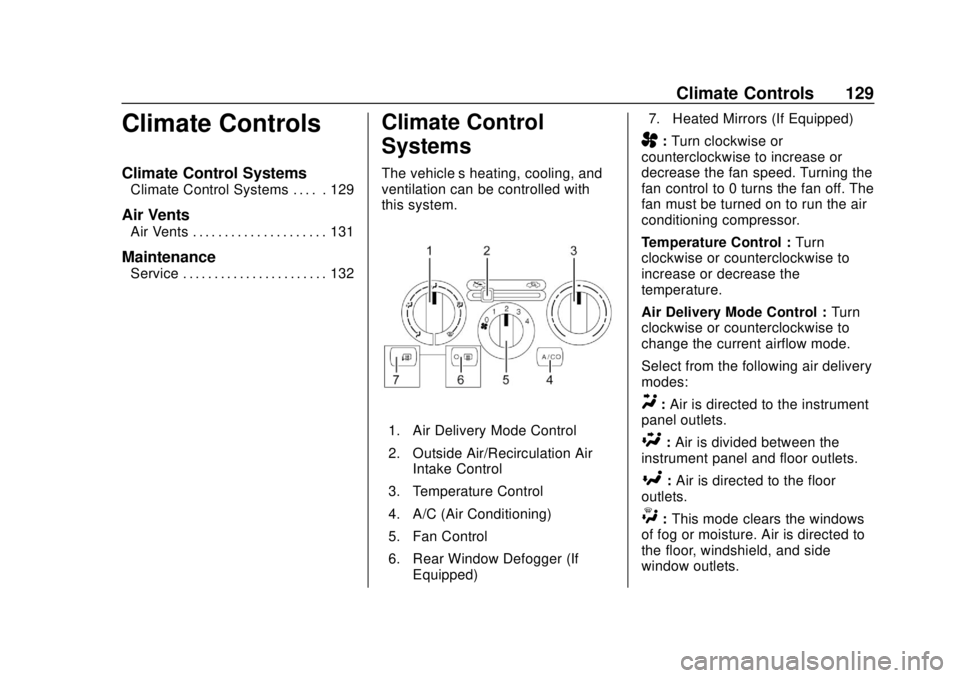
Chevrolet City Express Owner Manual (GMNA-Localizing-U.S./Canada-
11683523) - 2018 - CRC - 7/10/17
Climate Controls 129
Climate Controls
Climate Control Systems
Climate Control Systems . . . . . 129
Air Vents
Air Vents . . . . . . . . . . . . . . . . . . . . . 131
Maintenance
Service . . . . . . . . . . . . . . . . . . . . . . . 132
Climate Control
Systems
The vehicle’s heating, cooling, and
ventilation can be controlled with
this system.
1. Air Delivery Mode Control
2. Outside Air/Recirculation AirIntake Control
3. Temperature Control
4. A/C (Air Conditioning)
5. Fan Control
6. Rear Window Defogger (If Equipped) 7. Heated Mirrors (If Equipped)
A:
Turn clockwise or
counterclockwise to increase or
decrease the fan speed. Turning the
fan control to 0 turns the fan off. The
fan must be turned on to run the air
conditioning compressor.
Temperature Control : Turn
clockwise or counterclockwise to
increase or decrease the
temperature.
Air Delivery Mode Control : Turn
clockwise or counterclockwise to
change the current airflow mode.
Select from the following air delivery
modes:
Y: Air is directed to the instrument
panel outlets.
\: Air is divided between the
instrument panel and floor outlets.
[: Air is directed to the floor
outlets.
W: This mode clears the windows
of fog or moisture. Air is directed to
the floor, windshield, and side
window outlets.
Page 139 of 287
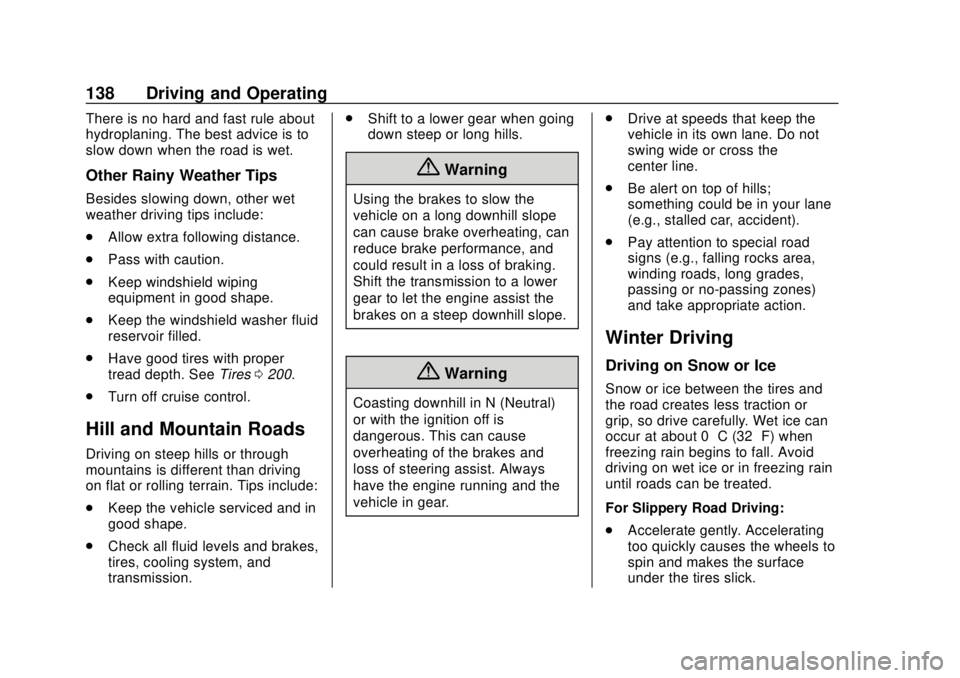
Chevrolet City Express Owner Manual (GMNA-Localizing-U.S./Canada-
11683523) - 2018 - CRC - 7/10/17
138 Driving and Operating
There is no hard and fast rule about
hydroplaning. The best advice is to
slow down when the road is wet.
Other Rainy Weather Tips
Besides slowing down, other wet
weather driving tips include:
.Allow extra following distance.
. Pass with caution.
. Keep windshield wiping
equipment in good shape.
. Keep the windshield washer fluid
reservoir filled.
. Have good tires with proper
tread depth. See Tires0200.
. Turn off cruise control.
Hill and Mountain Roads
Driving on steep hills or through
mountains is different than driving
on flat or rolling terrain. Tips include:
.
Keep the vehicle serviced and in
good shape.
. Check all fluid levels and brakes,
tires, cooling system, and
transmission. .
Shift to a lower gear when going
down steep or long hills.
{Warning
Using the brakes to slow the
vehicle on a long downhill slope
can cause brake overheating, can
reduce brake performance, and
could result in a loss of braking.
Shift the transmission to a lower
gear to let the engine assist the
brakes on a steep downhill slope.
{Warning
Coasting downhill in N (Neutral)
or with the ignition off is
dangerous. This can cause
overheating of the brakes and
loss of steering assist. Always
have the engine running and the
vehicle in gear. .
Drive at speeds that keep the
vehicle in its own lane. Do not
swing wide or cross the
center line.
. Be alert on top of hills;
something could be in your lane
(e.g., stalled car, accident).
. Pay attention to special road
signs (e.g., falling rocks area,
winding roads, long grades,
passing or no-passing zones)
and take appropriate action.
Winter Driving
Driving on Snow or Ice
Snow or ice between the tires and
the road creates less traction or
grip, so drive carefully. Wet ice can
occur at about 0 °C (32 °F) when
freezing rain begins to fall. Avoid
driving on wet ice or in freezing rain
until roads can be treated.
For Slippery Road Driving:
.Accelerate gently. Accelerating
too quickly causes the wheels to
spin and makes the surface
under the tires slick.
Page 177 of 287
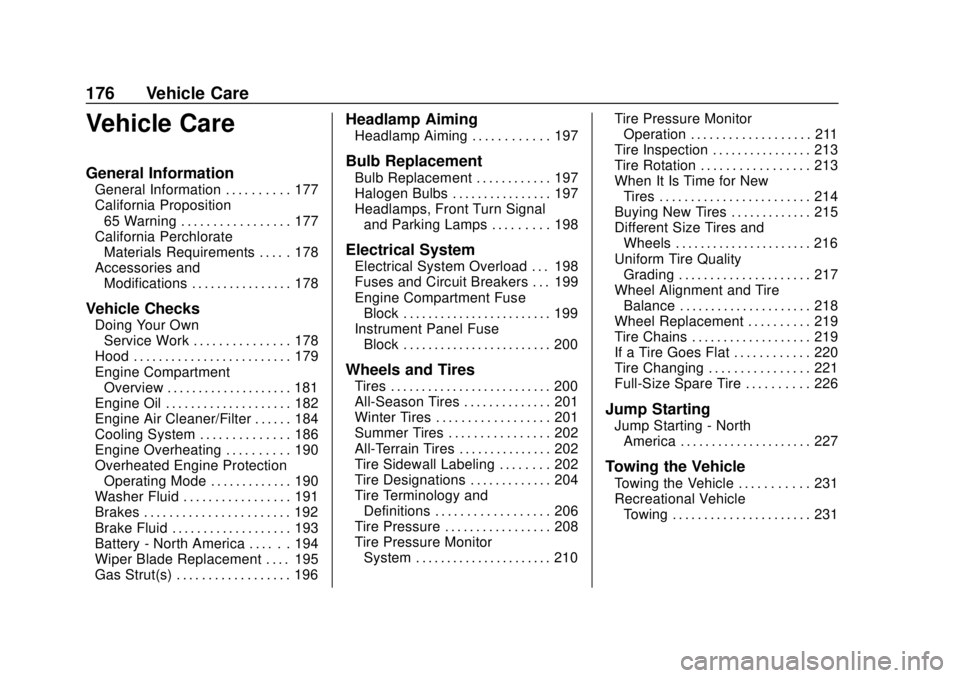
Chevrolet City Express Owner Manual (GMNA-Localizing-U.S./Canada-
11683523) - 2018 - CRC - 7/10/17
176 Vehicle Care
Vehicle Care
General Information
General Information . . . . . . . . . . 177
California Proposition65 Warning . . . . . . . . . . . . . . . . . 177
California Perchlorate Materials Requirements . . . . . 178
Accessories and Modifications . . . . . . . . . . . . . . . . 178
Vehicle Checks
Doing Your OwnService Work . . . . . . . . . . . . . . . 178
Hood . . . . . . . . . . . . . . . . . . . . . . . . . 179
Engine Compartment Overview . . . . . . . . . . . . . . . . . . . . 181
Engine Oil . . . . . . . . . . . . . . . . . . . . 182
Engine Air Cleaner/Filter . . . . . . 184
Cooling System . . . . . . . . . . . . . . 186
Engine Overheating . . . . . . . . . . 190
Overheated Engine Protection Operating Mode . . . . . . . . . . . . . 190
Washer Fluid . . . . . . . . . . . . . . . . . 191
Brakes . . . . . . . . . . . . . . . . . . . . . . . 192
Brake Fluid . . . . . . . . . . . . . . . . . . . 193
Battery - North America . . . . . . 194
Wiper Blade Replacement . . . . 195
Gas Strut(s) . . . . . . . . . . . . . . . . . . 196
Headlamp Aiming
Headlamp Aiming . . . . . . . . . . . . 197
Bulb Replacement
Bulb Replacement . . . . . . . . . . . . 197
Halogen Bulbs . . . . . . . . . . . . . . . . 197
Headlamps, Front Turn Signal and Parking Lamps . . . . . . . . . 198
Electrical System
Electrical System Overload . . . 198
Fuses and Circuit Breakers . . . 199
Engine Compartment FuseBlock . . . . . . . . . . . . . . . . . . . . . . . . 199
Instrument Panel Fuse Block . . . . . . . . . . . . . . . . . . . . . . . . 200
Wheels and Tires
Tires . . . . . . . . . . . . . . . . . . . . . . . . . . 200
All-Season Tires . . . . . . . . . . . . . . 201
Winter Tires . . . . . . . . . . . . . . . . . . 201
Summer Tires . . . . . . . . . . . . . . . . 202
All-Terrain Tires . . . . . . . . . . . . . . . 202
Tire Sidewall Labeling . . . . . . . . 202
Tire Designations . . . . . . . . . . . . . 204
Tire Terminology andDefinitions . . . . . . . . . . . . . . . . . . 206
Tire Pressure . . . . . . . . . . . . . . . . . 208
Tire Pressure Monitor System . . . . . . . . . . . . . . . . . . . . . . 210 Tire Pressure Monitor
Operation . . . . . . . . . . . . . . . . . . . 211
Tire Inspection . . . . . . . . . . . . . . . . 213
Tire Rotation . . . . . . . . . . . . . . . . . 213
When It Is Time for New Tires . . . . . . . . . . . . . . . . . . . . . . . . 214
Buying New Tires . . . . . . . . . . . . . 215
Different Size Tires and Wheels . . . . . . . . . . . . . . . . . . . . . . 216
Uniform Tire Quality Grading . . . . . . . . . . . . . . . . . . . . . 217
Wheel Alignment and Tire Balance . . . . . . . . . . . . . . . . . . . . . 218
Wheel Replacement . . . . . . . . . . 219
Tire Chains . . . . . . . . . . . . . . . . . . . 219
If a Tire Goes Flat . . . . . . . . . . . . 220
Tire Changing . . . . . . . . . . . . . . . . 221
Full-Size Spare Tire . . . . . . . . . . 226
Jump Starting
Jump Starting - North America . . . . . . . . . . . . . . . . . . . . . 227
Towing the Vehicle
Towing the Vehicle . . . . . . . . . . . 231
Recreational VehicleTowing . . . . . . . . . . . . . . . . . . . . . . 231
Page 183 of 287
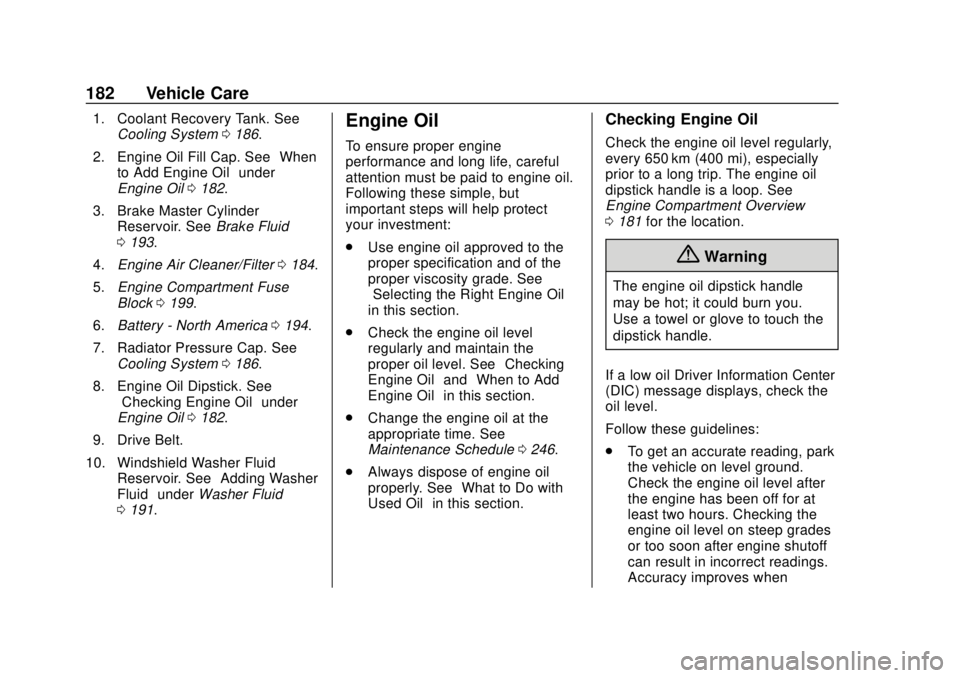
Chevrolet City Express Owner Manual (GMNA-Localizing-U.S./Canada-
11683523) - 2018 - CRC - 7/10/17
182 Vehicle Care
1. Coolant Recovery Tank. SeeCooling System 0186.
2. Engine Oil Fill Cap. See “When
to Add Engine Oil” under
Engine Oil 0182.
3. Brake Master Cylinder Reservoir. See Brake Fluid
0 193.
4. Engine Air Cleaner/Filter 0184.
5. Engine Compartment Fuse
Block 0199.
6. Battery - North America 0194.
7. Radiator Pressure Cap. See Cooling System 0186.
8. Engine Oil Dipstick. See “Checking Engine Oil” under
Engine Oil 0182.
9. Drive Belt.
10. Windshield Washer Fluid Reservoir. See “Adding Washer
Fluid” under Washer Fluid
0 191.Engine Oil
To ensure proper engine
performance and long life, careful
attention must be paid to engine oil.
Following these simple, but
important steps will help protect
your investment:
.
Use engine oil approved to the
proper specification and of the
proper viscosity grade. See
“Selecting the Right Engine Oil”
in this section.
. Check the engine oil level
regularly and maintain the
proper oil level. See “Checking
Engine Oil” and“When to Add
Engine Oil” in this section.
. Change the engine oil at the
appropriate time. See
Maintenance Schedule 0246.
. Always dispose of engine oil
properly. See “What to Do with
Used Oil” in this section.
Checking Engine Oil
Check the engine oil level regularly,
every 650 km (400 mi), especially
prior to a long trip. The engine oil
dipstick handle is a loop. See
Engine Compartment Overview
0181 for the location.
{Warning
The engine oil dipstick handle
may be hot; it could burn you.
Use a towel or glove to touch the
dipstick handle.
If a low oil Driver Information Center
(DIC) message displays, check the
oil level.
Follow these guidelines:
. To get an accurate reading, park
the vehicle on level ground.
Check the engine oil level after
the engine has been off for at
least two hours. Checking the
engine oil level on steep grades
or too soon after engine shutoff
can result in incorrect readings.
Accuracy improves when
Page 187 of 287
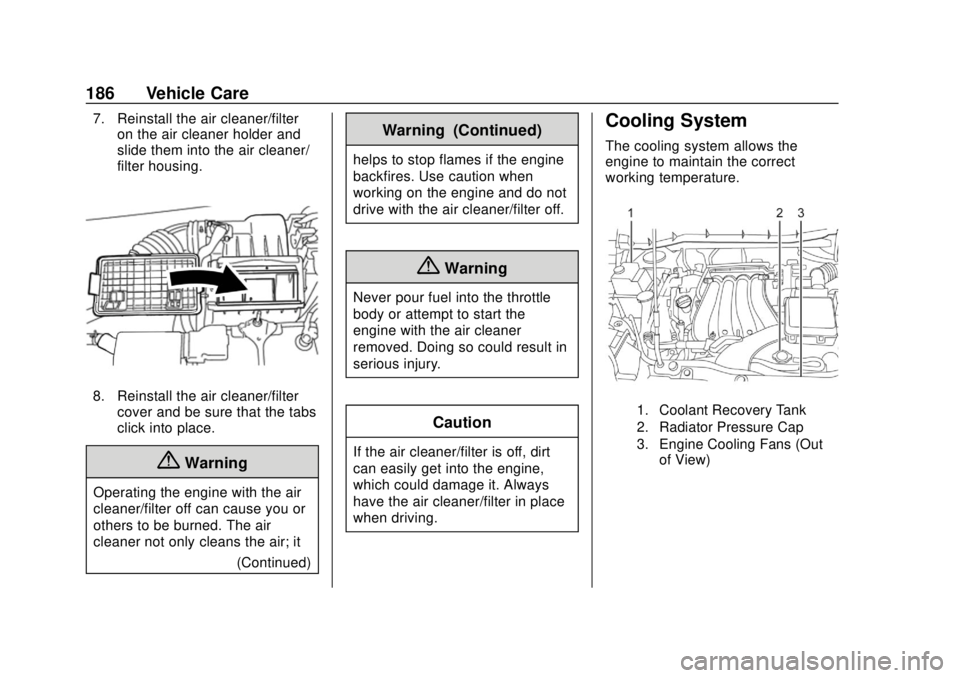
Chevrolet City Express Owner Manual (GMNA-Localizing-U.S./Canada-
11683523) - 2018 - CRC - 7/10/17
186 Vehicle Care
7. Reinstall the air cleaner/filteron the air cleaner holder and
slide them into the air cleaner/
filter housing.
8. Reinstall the air cleaner/filter
cover and be sure that the tabs
click into place.
{Warning
Operating the engine with the air
cleaner/filter off can cause you or
others to be burned. The air
cleaner not only cleans the air; it
(Continued)
Warning (Continued)
helps to stop flames if the engine
backfires. Use caution when
working on the engine and do not
drive with the air cleaner/filter off.
{Warning
Never pour fuel into the throttle
body or attempt to start the
engine with the air cleaner
removed. Doing so could result in
serious injury.
Caution
If the air cleaner/filter is off, dirt
can easily get into the engine,
which could damage it. Always
have the air cleaner/filter in place
when driving.
Cooling System
The cooling system allows the
engine to maintain the correct
working temperature.
1. Coolant Recovery Tank
2. Radiator Pressure Cap
3. Engine Cooling Fans (Outof View)
Page 188 of 287
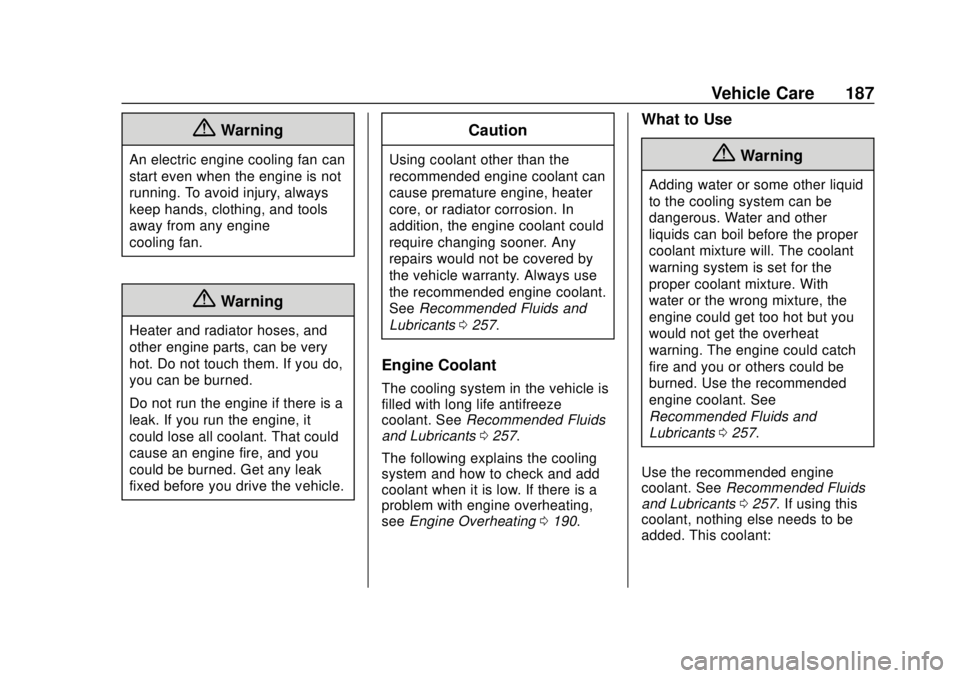
Chevrolet City Express Owner Manual (GMNA-Localizing-U.S./Canada-
11683523) - 2018 - CRC - 7/10/17
Vehicle Care 187
{Warning
An electric engine cooling fan can
start even when the engine is not
running. To avoid injury, always
keep hands, clothing, and tools
away from any engine
cooling fan.
{Warning
Heater and radiator hoses, and
other engine parts, can be very
hot. Do not touch them. If you do,
you can be burned.
Do not run the engine if there is a
leak. If you run the engine, it
could lose all coolant. That could
cause an engine fire, and you
could be burned. Get any leak
fixed before you drive the vehicle.
Caution
Using coolant other than the
recommended engine coolant can
cause premature engine, heater
core, or radiator corrosion. In
addition, the engine coolant could
require changing sooner. Any
repairs would not be covered by
the vehicle warranty. Always use
the recommended engine coolant.
SeeRecommended Fluids and
Lubricants 0257.
Engine Coolant
The cooling system in the vehicle is
filled with long life antifreeze
coolant. See Recommended Fluids
and Lubricants 0257.
The following explains the cooling
system and how to check and add
coolant when it is low. If there is a
problem with engine overheating,
see Engine Overheating 0190.
What to Use
{Warning
Adding water or some other liquid
to the cooling system can be
dangerous. Water and other
liquids can boil before the proper
coolant mixture will. The coolant
warning system is set for the
proper coolant mixture. With
water or the wrong mixture, the
engine could get too hot but you
would not get the overheat
warning. The engine could catch
fire and you or others could be
burned. Use the recommended
engine coolant. See
Recommended Fluids and
Lubricants 0257.
Use the recommended engine
coolant. See Recommended Fluids
and Lubricants 0257. If using this
coolant, nothing else needs to be
added. This coolant:
Page 189 of 287
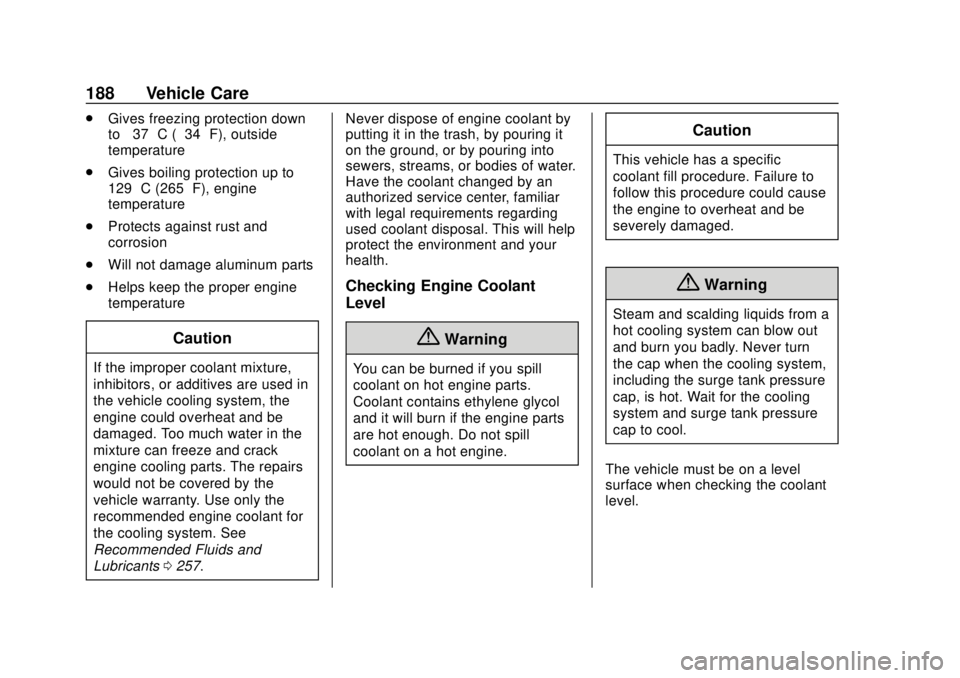
Chevrolet City Express Owner Manual (GMNA-Localizing-U.S./Canada-
11683523) - 2018 - CRC - 7/10/17
188 Vehicle Care
.Gives freezing protection down
to−37 °C (−34 °F), outside
temperature
. Gives boiling protection up to
129 °C (265 °F), engine
temperature
. Protects against rust and
corrosion
. Will not damage aluminum parts
. Helps keep the proper engine
temperature
Caution
If the improper coolant mixture,
inhibitors, or additives are used in
the vehicle cooling system, the
engine could overheat and be
damaged. Too much water in the
mixture can freeze and crack
engine cooling parts. The repairs
would not be covered by the
vehicle warranty. Use only the
recommended engine coolant for
the cooling system. See
Recommended Fluids and
Lubricants 0257. Never dispose of engine coolant by
putting it in the trash, by pouring it
on the ground, or by pouring into
sewers, streams, or bodies of water.
Have the coolant changed by an
authorized service center, familiar
with legal requirements regarding
used coolant disposal. This will help
protect the environment and your
health.
Checking Engine Coolant
Level
{Warning
You can be burned if you spill
coolant on hot engine parts.
Coolant contains ethylene glycol
and it will burn if the engine parts
are hot enough. Do not spill
coolant on a hot engine.
Caution
This vehicle has a specific
coolant fill procedure. Failure to
follow this procedure could cause
the engine to overheat and be
severely damaged.
{Warning
Steam and scalding liquids from a
hot cooling system can blow out
and burn you badly. Never turn
the cap when the cooling system,
including the surge tank pressure
cap, is hot. Wait for the cooling
system and surge tank pressure
cap to cool.
The vehicle must be on a level
surface when checking the coolant
level.
Page 190 of 287
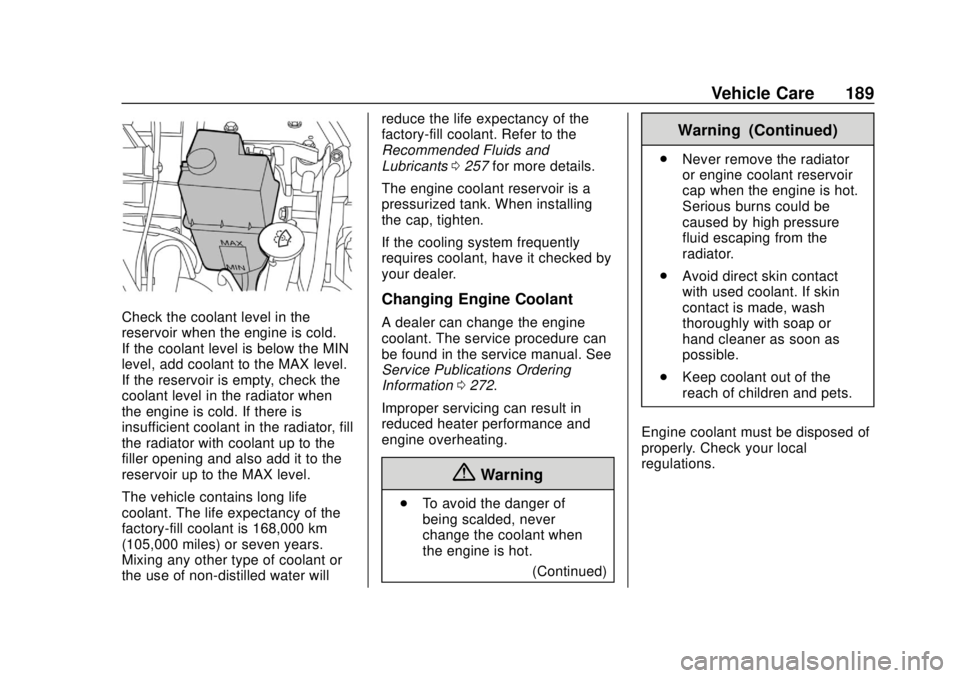
Chevrolet City Express Owner Manual (GMNA-Localizing-U.S./Canada-
11683523) - 2018 - CRC - 7/10/17
Vehicle Care 189
Check the coolant level in the
reservoir when the engine is cold.
If the coolant level is below the MIN
level, add coolant to the MAX level.
If the reservoir is empty, check the
coolant level in the radiator when
the engine is cold. If there is
insufficient coolant in the radiator, fill
the radiator with coolant up to the
filler opening and also add it to the
reservoir up to the MAX level.
The vehicle contains long life
coolant. The life expectancy of the
factory-fill coolant is 168,000 km
(105,000 miles) or seven years.
Mixing any other type of coolant or
the use of non-distilled water willreduce the life expectancy of the
factory-fill coolant. Refer to the
Recommended Fluids and
Lubricants
0257 for more details.
The engine coolant reservoir is a
pressurized tank. When installing
the cap, tighten.
If the cooling system frequently
requires coolant, have it checked by
your dealer.
Changing Engine Coolant
A dealer can change the engine
coolant. The service procedure can
be found in the service manual. See
Service Publications Ordering
Information 0272.
Improper servicing can result in
reduced heater performance and
engine overheating.
{Warning
. To avoid the danger of
being scalded, never
change the coolant when
the engine is hot.
(Continued)
Warning (Continued)
.Never remove the radiator
or engine coolant reservoir
cap when the engine is hot.
Serious burns could be
caused by high pressure
fluid escaping from the
radiator.
. Avoid direct skin contact
with used coolant. If skin
contact is made, wash
thoroughly with soap or
hand cleaner as soon as
possible.
. Keep coolant out of the
reach of children and pets.
Engine coolant must be disposed of
properly. Check your local
regulations.
Page 191 of 287
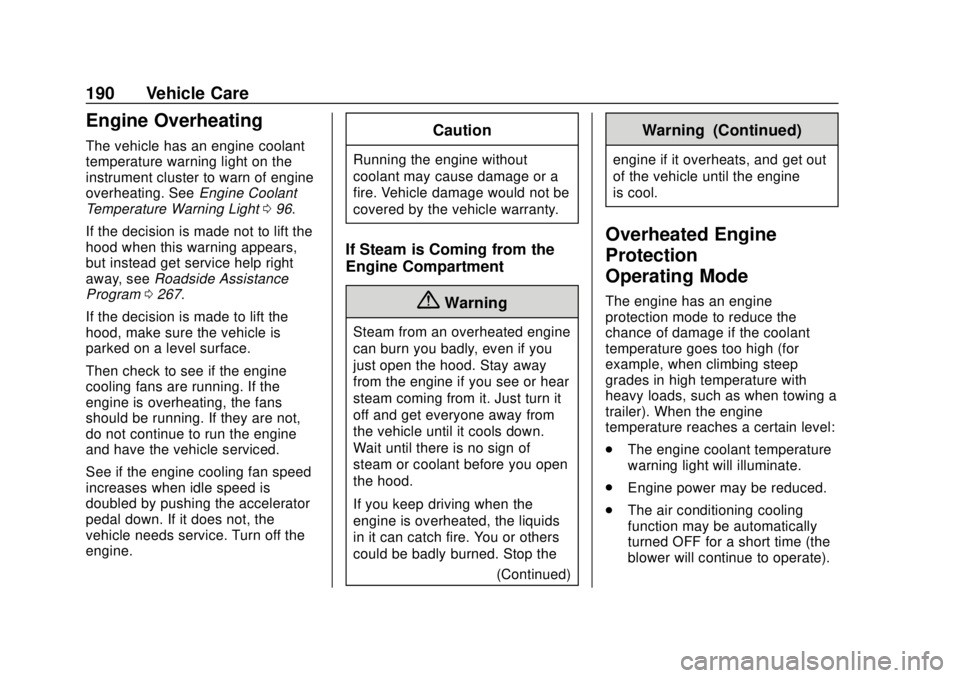
Chevrolet City Express Owner Manual (GMNA-Localizing-U.S./Canada-
11683523) - 2018 - CRC - 7/10/17
190 Vehicle Care
Engine Overheating
The vehicle has an engine coolant
temperature warning light on the
instrument cluster to warn of engine
overheating. SeeEngine Coolant
Temperature Warning Light 096.
If the decision is made not to lift the
hood when this warning appears,
but instead get service help right
away, see Roadside Assistance
Program 0267.
If the decision is made to lift the
hood, make sure the vehicle is
parked on a level surface.
Then check to see if the engine
cooling fans are running. If the
engine is overheating, the fans
should be running. If they are not,
do not continue to run the engine
and have the vehicle serviced.
See if the engine cooling fan speed
increases when idle speed is
doubled by pushing the accelerator
pedal down. If it does not, the
vehicle needs service. Turn off the
engine.Caution
Running the engine without
coolant may cause damage or a
fire. Vehicle damage would not be
covered by the vehicle warranty.
If Steam is Coming from the
Engine Compartment
{Warning
Steam from an overheated engine
can burn you badly, even if you
just open the hood. Stay away
from the engine if you see or hear
steam coming from it. Just turn it
off and get everyone away from
the vehicle until it cools down.
Wait until there is no sign of
steam or coolant before you open
the hood.
If you keep driving when the
engine is overheated, the liquids
in it can catch fire. You or others
could be badly burned. Stop the (Continued)
Warning (Continued)
engine if it overheats, and get out
of the vehicle until the engine
is cool.
Overheated Engine
Protection
Operating Mode
The engine has an engine
protection mode to reduce the
chance of damage if the coolant
temperature goes too high (for
example, when climbing steep
grades in high temperature with
heavy loads, such as when towing a
trailer). When the engine
temperature reaches a certain level:
.The engine coolant temperature
warning light will illuminate.
. Engine power may be reduced.
. The air conditioning cooling
function may be automatically
turned OFF for a short time (the
blower will continue to operate).